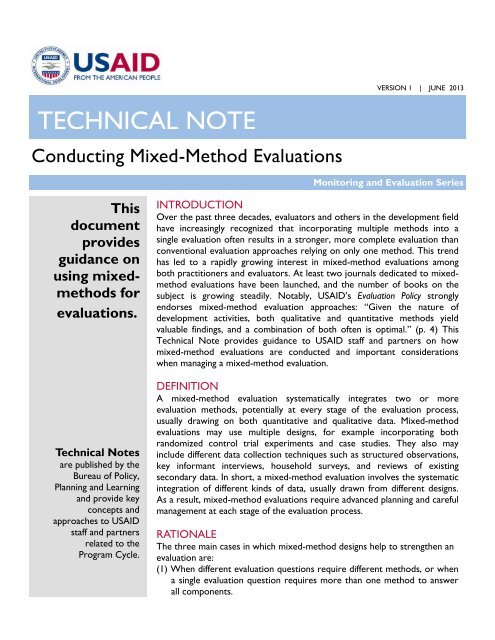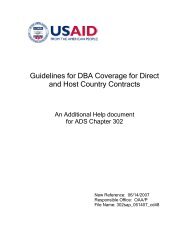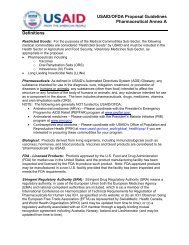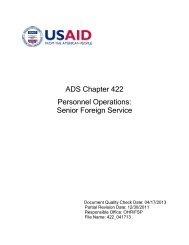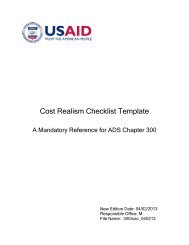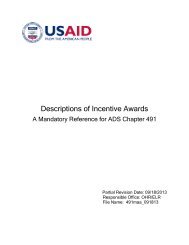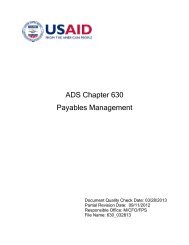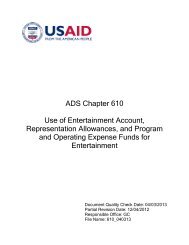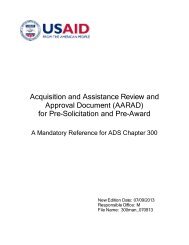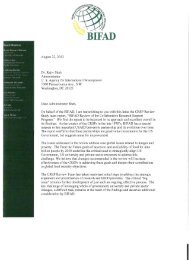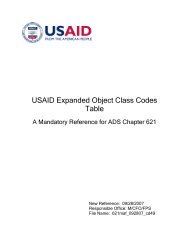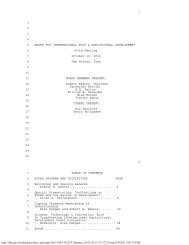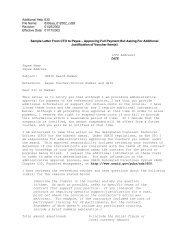Technical Note: Conducting Mixed Method Evaluations - usaid
Technical Note: Conducting Mixed Method Evaluations - usaid
Technical Note: Conducting Mixed Method Evaluations - usaid
You also want an ePaper? Increase the reach of your titles
YUMPU automatically turns print PDFs into web optimized ePapers that Google loves.
VERSION 1 | JUNE 2013<br />
TECHNICAL NOTE<br />
<strong>Conducting</strong> <strong>Mixed</strong>-<strong>Method</strong> <strong>Evaluations</strong><br />
Monitoring and Evaluation Series<br />
This<br />
document<br />
provides<br />
guidance on<br />
using mixedmethods<br />
for<br />
evaluations.<br />
<strong>Technical</strong> <strong>Note</strong>s<br />
are published by the<br />
Bureau of Policy,<br />
Planning and Learning<br />
and provide key<br />
concepts and<br />
approaches to USAID<br />
staff and partners<br />
related to the<br />
Program Cycle.<br />
RATIONALE<br />
INTRODUCTION<br />
Over the past three decades, evaluators and others in the development field<br />
have increasingly recognized that incorporating multiple methods into a<br />
single evaluation often results in a stronger, more complete evaluation than<br />
conventional evaluation approaches relying on only one method. This trend<br />
has led to a rapidly growing interest in mixed-method evaluations among<br />
both practitioners and evaluators. At least two journals dedicated to mixedmethod<br />
evaluations have been launched, and the number of books on the<br />
subject is growing steadily. Notably, USAID’s Evaluation Policy strongly<br />
endorses mixed-method evaluation approaches: “Given the nature of<br />
development activities, both qualitative and quantitative methods yield<br />
valuable findings, and a combination of both often is optimal.” (p. 4) This<br />
<strong>Technical</strong> <strong>Note</strong> provides guidance to USAID staff and partners on how<br />
mixed-method evaluations are conducted and important considerations<br />
when managing a mixed-method evaluation.<br />
DEFINITION<br />
A mixed-method evaluation systematically integrates two or more<br />
evaluation methods, potentially at every stage of the evaluation process,<br />
usually drawing on both quantitative and qualitative data. <strong>Mixed</strong>-method<br />
evaluations may use multiple designs, for example incorporating both<br />
randomized control trial experiments and case studies. They also may<br />
include different data collection techniques such as structured observations,<br />
key informant interviews, household surveys, and reviews of existing<br />
secondary data. In short, a mixed-method evaluation involves the systematic<br />
integration of different kinds of data, usually drawn from different designs.<br />
As a result, mixed-method evaluations require advanced planning and careful<br />
management at each stage of the evaluation process.<br />
RATIONALE<br />
The three main cases in which mixed-method designs help to strengthen an<br />
evaluation are:<br />
(1) When different evaluation questions require different methods, or when<br />
a single evaluation question requires more than one method to answer<br />
all components.
<strong>Technical</strong> <strong>Note</strong> on <strong>Conducting</strong> <strong>Mixed</strong>-<strong>Method</strong> <strong>Evaluations</strong><br />
(2) When different methods are used to answer the same elements of a single question, increasing confidence<br />
in the validity and reliability of the evaluation results.<br />
(3) When the results from one method are used to help design future phases of the evaluation using other<br />
methods.<br />
In addition to these three main reasons, there are other benefits that can be realized by using mixed-method<br />
designs or data collection strategies. For example, mixed-methods approaches:<br />
Are more likely to reveal unanticipated results.<br />
Can provide a deeper understanding of why change is or is not occurring as planned.<br />
Often capture a wider range of perspectives than might be captured by a single method.<br />
(1) USING DIFFERENT METHODS TO ANSWER DIFFERENT QUESTIONS OR TO<br />
ANSWER DIFFERENT PARTS OF THE SAME QUESTION<br />
In many cases, one evaluation method will be insufficient to answer all of the questions included in an<br />
evaluation statement of work (SOW). For example, suppose an SOW involves an evaluation of a project that<br />
includes a new teaching technique, and includes two questions: #1. “Was there a statistically significant<br />
difference between female and male students’ academic achievement test scores?” and #2. “How did students’<br />
parents perceive the effects of the project?” A single method will likely be insufficient to adequately answer<br />
both of these questions.<br />
To answer the first question, the evaluator might choose a quasi-experimental design that uses existing test<br />
scores from before project implementation and new test scores from after completion to compare the<br />
performance of male and female students. This approach would address the question of whether the program<br />
resulted in differences in test scores between females and males. But these methods would not help to answer<br />
question #2. To understand parent perceptions, the evaluator likely would use individual or focus group<br />
interviews of a sample of parents, and perhaps conduct an evaluative case study in order to more deeply<br />
understand how parents view the program.<br />
Sometimes, one evaluation question may contain multiple parts, and it<br />
may be necessary to use different methods to address each part. For<br />
example, question #1 could be changed slightly to ask, “Was there a<br />
statistically significant difference between female and male students’<br />
scores? And, what explains possible gender differences in test scores?” In<br />
this case, simply relying on test scores in a quasi-experimental design<br />
would be insufficient. To understand the mechanism behind differences in<br />
female and male scores would require a different method, such as key<br />
informant interviews with teachers or focus group discussions with<br />
students.<br />
(2) USING DIFFERENT METHODS TO ANSWER THE SAME<br />
QUESTION: TRIANGULATION<br />
Even if an evaluation question can be answered using only one method,<br />
often it is preferable to combine multiple methods to answer the same<br />
A NOTE ON<br />
TERMINOLOGY<br />
In the literature on evaluation,<br />
“method” is sometimes used to<br />
refer to a data collection<br />
technique (interviews, surveys,<br />
observations), and other times to<br />
an evaluation design or approach<br />
(experimental, quasi-experimental,<br />
non-experimental). Though the<br />
definition is not completely settled<br />
in the literature, this <strong>Technical</strong><br />
<strong>Note</strong> treats evaluations that<br />
combine methods in either sense<br />
as mixed-method evaluations.<br />
question in order to gain a more complete understanding of the issue and more confidence in the findings. By<br />
approaching the same question from more than one perspective or by using more than one technique,<br />
evaluators can then compare and contrast the results from these different methods. This process is known as<br />
triangulation. If the findings from the different methods are similar, or reinforce one another, then users can<br />
have greater confidence in the findings than if they are based on only one method.<br />
2
<strong>Technical</strong> <strong>Note</strong> on <strong>Conducting</strong> <strong>Mixed</strong>-<strong>Method</strong> <strong>Evaluations</strong><br />
If the findings from different methods vary significantly, the user and evaluator must carefully consider what<br />
might have happened to produce these divergent findings. One possible explanation could be bias in one set of<br />
data. Triangulation can help to minimize bias in cases like these, with data from one method acting as a check<br />
or balance against data from another method. For example, evaluators may use secondary data from the<br />
Ministry of Economy to measure changes in exports related to a trade facilitation project. But they may also<br />
suspect that firms are underreporting their exports to the government in order to pay less in taxes. To help<br />
QUICK ADVICE FOR THE USAID<br />
EVALUATION MANAGER<br />
<strong>Mixed</strong> method evaluation involves the systematic<br />
integration of different kinds of data, usually<br />
drawn from different evaluation designs. As a<br />
result, mixed-method evaluations require<br />
advanced planning and affect the evaluation<br />
budget.<br />
<strong>Mixed</strong> method evaluations yield valuable findings,<br />
and a combination of both is often optimal given<br />
the nature of development activities. <strong>Mixed</strong><br />
methods are more likely to reveal unanticipated<br />
results (a key advantage of evaluation over<br />
performance monitoring), which can provide a<br />
deeper understanding of why change is or isn’t<br />
taking place as planned. It often captures a wider<br />
range of perspectives than might be captured by a<br />
single method.<br />
At the planning stage, the evaluation manager<br />
must decide which methods to use and how to<br />
combine them. These decisions will be based<br />
primarily on the purpose of the evaluation and the<br />
key evaluation questions, but evaluation managers<br />
must also take into account factors such as time<br />
and cost. An evaluation manager should seek<br />
advice from a colleague with evaluation design<br />
expertise, as needed.<br />
Lastly, using mixed methods requires mixed skills<br />
on the evaluation team. It is important to consider<br />
during the planning stage what kind of skills will be<br />
needed in order to conduct each aspect of the<br />
evaluation successfully, and then to select team<br />
members accordingly.<br />
mitigate the risk of bias caused by this underreporting<br />
in the government data, the evaluation team may<br />
distribute a survey to supported firms and also<br />
conduct in-depth interviews with key informants from<br />
a sub-sample of firms in order to obtain a more<br />
accurate picture of how the project has influenced<br />
exports. Evaluators looking to answer one question<br />
with multiple methods often combine them using the<br />
parallel process described below. It is important for<br />
the evaluation manager to understand how this<br />
process of triangulation will work, because it has<br />
implications for the resources needed to carry out<br />
such an evaluation.<br />
(3) USING ONE METHOD TO INFORM THE<br />
DESIGN OF ANOTHER METHOD<br />
In some cases, one method can be used to help guide<br />
the use of another method, or to explain the findings<br />
from another method. In the first case, imagine an<br />
SOW for the evaluation of a youth vocational training<br />
project including the evaluation question: “Why do<br />
youth choose to participate in project activities?” The<br />
evaluator may wish to conduct a survey of participants,<br />
but be unsure how to word the questions, or what<br />
answer choices to include. By first conducting<br />
individual and focus group interviews with participants<br />
and non-participants, the evaluator may be able to<br />
identify some common reasons for participation among<br />
the target population, and then use these data to<br />
construct the survey. In this way, the qualitative<br />
methods (individual and focus group interviews),<br />
conducted first, can inform the quantitative method<br />
(survey), that comes afterward. Because this use of<br />
mixed-method evaluation requires each method to be<br />
sequenced, one after the other, these methods are<br />
often incorporated into mixed-method evaluations<br />
using sequential processes. Again, this design choice<br />
has time and resource implications, as discussed below.<br />
HOW TO MIX METHODS<br />
As mentioned above, evaluators must consider carefully how they will integrate the different methods used<br />
into a coherent, thoughtful evaluation design. This section outlines three of the most common ways in which<br />
3
<strong>Technical</strong> <strong>Note</strong> on <strong>Conducting</strong> <strong>Mixed</strong>-<strong>Method</strong> <strong>Evaluations</strong><br />
methods can be combined to accomplish the purposes described above: parallel combinations, sequential<br />
combinations, and multi-level combinations. (Table 2, at the end of this document, lists two additional<br />
techniques: conversion and data synthesis; for purposes of this note, however, the three techniques discussed<br />
in the text are sufficient to provide an overview of the issues.) A single evaluation might use more than one,<br />
or even all, of these combination patterns at different points during the evaluation process.<br />
Each of these variations involves important management decisions on issues such as which data sources to rely<br />
on and how to gain access to them, what sites should be included in the evaluation (all project sites or a<br />
sample, and if just a sample, how the sample should be drawn), how much depth of explanation is needed,<br />
which stakeholders’ views are most relevant, and so on. These kinds of questions normally need to be<br />
addressed in the SOW so that the evaluators can develop designs that answer the questions of interest. And<br />
while the evaluators may help to clarify questions and provide guidance on practical implications of design<br />
choices, it is the responsibility of the USAID managers to have made the key decisions, such as what questions<br />
need to be answered and what kinds of evidence are needed, when developing the SOW. These choices have<br />
important implications for time and resources. <strong>Mixed</strong>-method evaluations must be carefully planned with a<br />
thorough understanding of why and how each method is to be used to answer the questions. One must<br />
carefully consider the integrity of the design of the evaluation. Adding more methods to a design with the idea<br />
that “more is better” can lead to unnecessary complications and cost.<br />
PARALLEL COMBINATIONS<br />
In parallel combinations, methods are used separately and the findings are integrated after the data are<br />
analyzed. The same evaluation team might be involved in implementing multiple evaluation methods, and the<br />
actual data collection and analysis can happen over the same period of time, or at different times. The key<br />
point is that in parallel combinations, each method is conducted in its entirety, separately from<br />
the other methods, as shown in Figure 1.<br />
For example, a team evaluating an<br />
alternative development project could FIGURE 1: PARALLEL COMBINATIONS<br />
collect data from government statistics<br />
on the number of acres of land<br />
converted from illegal to legal crops,<br />
and then analyze this quantitative data<br />
to estimate the impact of the project.<br />
At the same time, the same team also<br />
might conduct individual and focus<br />
group interviews with farmers to better understand their choice of what to grow. These two methods could<br />
take place simultaneously, and the data analyzed separately. Then, if the data from the two methods were<br />
intended to answer the same question, the findings could be triangulated. If they were intended to answer<br />
different questions, then the results would be combined, or synthesized, in the evaluation report.<br />
SEQUENTIAL COMBINATION<br />
Multiple methods also can be used at different times and in a specific order. With sequential<br />
combinations, methods are employed one after the other, with the findings from methods used<br />
earlier in the evaluation informing the design and implementation of methods used later in the<br />
evaluation.<br />
4
<strong>Technical</strong> <strong>Note</strong> on <strong>Conducting</strong> <strong>Mixed</strong>-<strong>Method</strong> <strong>Evaluations</strong><br />
Round 1 data collection:<br />
Based on the evaluation FIGURE 2: SEQUENTIAL COMBINATIONS<br />
design, the evaluator<br />
constructs data collection<br />
instruments, conducts a first<br />
round of data collection,<br />
and analyzes that data. For<br />
example, as illustrated in<br />
Figure 2, if the evaluation is<br />
intended to determine<br />
whether a water, sanitation and hygiene (WASH) project is leading to higher rates of hand-washing in a<br />
particular community, the evaluator may first collect and analyze quantitative data from the most recent<br />
census to gather information about the population of the community and any relevant demographic<br />
characteristics, such as age, socio-economic status, and ethnicity.<br />
Use of Round 1 findings to inform Round 2 data collection: The evaluator then can use the findings<br />
from the first round of data collection to inform the second round. In this example, the census data would<br />
help the evaluators identify the demographic characteristics that should be represented among the secondround<br />
interviewees. These interviews would help bring to light the common reasons why the affected<br />
population chooses to wash their hands, or not, and what obstacles may exist that prevent them from doing<br />
so.<br />
Use of Round 1 and 2 findings to inform Round 3 data collection: Based on qualitative information<br />
collected during the interviews, the evaluator would design the content of a household survey. This survey<br />
would help to answer the central question of what proportion of villagers has changed their hand-washing<br />
behavior, as well as why their behavior changed. The household survey would be conducted in the community,<br />
possibly following a sampling strategy based on Round 1 quantitative data. The data collected during the<br />
Round 3 household survey would directly address the original evaluation questions. While it might be possible<br />
to do only a survey, the mixed methods approach would have a number of advantages: thanks to the Round 1<br />
analysis the sample would be more representative of the total population of the village, and the survey<br />
questions would be more appropriately tailored to the local context and to the diversity of the community<br />
thanks to the Round 2 analysis.<br />
MULTILEVEL COMBINATIONS<br />
Many projects involve systems with multiple levels, and the evaluators of these projects often must collect<br />
data and draw conclusions about each of these levels in order to have a clear understanding of the overall<br />
performance of the project. Not surprisingly, the evaluator may conclude that different kinds of methods are<br />
best suited to collecting and analyzing information from different levels.<br />
For an example of this type of evaluation, consider an education project which is intended to raise student<br />
literacy by introducing more effective teaching strategies in a set of project schools. The project is designed so<br />
that the head teacher from each project school is trained by project trainers at the district level, and these<br />
teachers then return to their own schools to train their fellow teachers.<br />
5
<strong>Technical</strong> <strong>Note</strong> on <strong>Conducting</strong> <strong>Mixed</strong>-<strong>Method</strong> <strong>Evaluations</strong><br />
To understand whether the project has been effective, the evaluator will need to collect data on student<br />
literacy, likely based on the scores on a<br />
standardized test. But to understand why the FIGURE 3: MULTILEVEL COMBINATIONS<br />
project has been effective or not will also<br />
require data from additional levels. As shown<br />
in Figure 3, the evaluator may also want to<br />
collect attendance data from the trainings that<br />
occurred at the district level and conduct indepth<br />
and focus group interviews with the<br />
project trainers responsible for that training.<br />
At the school level, the same type of data<br />
could be collected from both the teachers who<br />
received the district training, and from those<br />
other teachers who received the trainings in<br />
their own schools. The evaluator may also<br />
conduct structured observations of classrooms<br />
in project schools in order to see firsthand<br />
whether teachers are using the literacy<br />
techniques promoted by the trainings. Incorporating different types of data at these different levels provides<br />
the evaluator with a more complete, holistic understanding of how the project operates and how it achieved,<br />
or did not achieve, its goals.<br />
Multi-level mixed-method evaluations can be combined with either parallel or sequential processes, or a<br />
combination of the two, depending on the levels of the project and the purpose of the evaluation. In the<br />
example above, there is a parallel process embedded in the multi-level design. However, integrating different<br />
types of data at different levels like this does make the overall evaluation design more complex, and requires<br />
additional planning, coordination, and management of the evaluation to make sure that all the data collected<br />
are analyzed and incorporated into the final report. While much of this responsibility necessarily falls to the<br />
evaluators, the implication for managers is that they must provide careful oversight of this complex evaluation<br />
process to ensure that the efforts are timely and well-coordinated, and carried out within time and budget<br />
constraints. Thus, from the manager’s point of view there is a trade-off between the quality of these mixedmethod<br />
evaluations in terms of accuracy and completeness, and the time and resource costs necessary to<br />
carry them out.<br />
INTEGRATING MULTIPLE METHODS INTO THE EVALUATION<br />
In order to get the most out of a mixed-method evaluation, the evaluation manager and the evaluator must<br />
consider carefully what purpose each method is intended to fulfill, and how they will be combined, at each<br />
stage of the evaluation, to most efficiently and effectively accomplish these purposes.<br />
PLANNING THE EVALUATION<br />
In order to conduct a successful mixed-method evaluation, the evaluator must start at the planning stage. At<br />
this point, the evaluator or evaluation manager must decide which methods to use and how to combine them.<br />
These decisions will be based primarily on the purpose of the evaluation and the key evaluation questions, but<br />
evaluation managers must also take into account factors such as time and cost.<br />
When drafting the evaluation SOW (Scope of Work), the evaluation manager must first decide which<br />
questions need to be answered and how rigorous the evaluation needs to be. If the evaluation is intended to<br />
estimate impact that can be attributed to a specific intervention, then the evaluation will include some kind of<br />
experimental or quasi-experimental design which typically includes a control or comparison group. This<br />
6
<strong>Technical</strong> <strong>Note</strong> on <strong>Conducting</strong> <strong>Mixed</strong>-<strong>Method</strong> <strong>Evaluations</strong><br />
decision must be made at the planning stage of the project so the project design and management will allow<br />
for this kind of evaluation design. If the evaluation is intended to answers questions more oriented toward<br />
project management, then non-experimental designs likely will be sufficient. In cases in which an evaluation<br />
needs to answer both attribution-related and other types of questions, the evaluation manager may choose an<br />
evaluation that incorporates aspects of both experimental (or quasi-experimental) and non-experimental<br />
designs. If at the planning stage the managers decide that the evaluation requires mixed-methods, they need to<br />
be aware that it will require careful management throughout the evaluation to ensure they accomplish their<br />
dual purposes.<br />
To see how combining these kinds of methods, or evaluation designs, can strengthen an evaluation, imagine a<br />
project that aims to increase farmers’ income by training them in improved farming techniques. The project<br />
design stipulates treatment and control groups in order to allow an evaluation to measure the contribution of<br />
the project to increased farmer income. In this case, the evaluation manager might decide on a quasiexperimental<br />
design with a treatment group, who receive the training, and a control group, who do not. At<br />
the same time, the evaluation also may aim to determine whether the project was implemented according to<br />
its original design, and this part of the evaluation may rely on a non-experimental design, focusing on a<br />
description of project operations, to fulfill this aim. The quasi-experimental component of the evaluation may<br />
reveal no significant difference in income between farmers in the<br />
treatment group and those in the control group, which would<br />
indicate that the project had no impact. Some stakeholders may<br />
also conclude from this finding that training projects of this kind do<br />
not increase farmer’s incomes. At the same time, the results of the<br />
non-experimental component of the evaluation may reveal that only<br />
a small number of farmers in the treatment group actually received<br />
the intended training, or that they all did receive the training and<br />
then shared the improved farming techniques with the farmers in<br />
the control group. In either case, this additional information would<br />
help to explain the findings of the quasi-experimental part of the<br />
evaluation: it is possible that training of this type can lead to<br />
increases in farmers’ income, but because of faulty implementation,<br />
it is impossible to know for sure from this evaluation.<br />
Once the evaluation team has finalized the overall evaluation design,<br />
the next step is to plan for data collection. In some cases, the<br />
evaluator may choose to begin using multiple data collection<br />
CHOOSING THE RIGHT<br />
EVALUATION TEAM<br />
<strong>Mixed</strong>-method evaluations require<br />
specialists with different kinds of<br />
skills. Even if an evaluator can<br />
construct a statistical regression<br />
model, this does not mean that the<br />
same person will be able to conduct<br />
a structured observation or<br />
effectively facilitate a focus group<br />
interview. It is important to consider<br />
during the planning stage what kind<br />
of skills will be needed in order to<br />
conduct each aspect of the evaluation<br />
successfully, and then to select team<br />
members accordingly.<br />
methods even during the planning stage, to help design tools or methodologies that then will be used during<br />
the data collection or data analysis stages of the overall evaluation. This use of mixed methods follows the<br />
sequential pattern of combining methods described above. A review of relevant literature and secondary data<br />
is one method commonly employed at the planning stage. Stakeholder consultations, also a common part of<br />
the planning stage, can take the form of individual and focus group interviews. The evaluator also could decide<br />
to conduct a mini-survey of some of the stakeholders to quickly get data from a larger group of people than is<br />
possible with in-depth interviews. The range of methods selected during the planning stage will depend in part<br />
on what data is already available.<br />
For example, if the data the evaluator needs are available for the whole population in secondary data sources,<br />
such as government statistics, then there may be no reason to do a mini-survey. Alternatively, it may be<br />
beneficial to conduct focus group interviews with certain groups of stakeholders, but there may not be enough<br />
time before the start of the evaluation to do so. The evaluation manager must think carefully about the<br />
information needed to plan the rest of the evaluation, how these different methods would contribute to this<br />
7
<strong>Technical</strong> <strong>Note</strong> on <strong>Conducting</strong> <strong>Mixed</strong>-<strong>Method</strong> <strong>Evaluations</strong><br />
planning, and how best to spend the resources available for the evaluation. Using a mix of methods at the<br />
planning stage can greatly strengthen evaluations, and if appropriate, the evaluation manager should include<br />
guidance for their use at this stage in the evaluation SOW.<br />
Whether a mix of methods is applied during the planning stage or not, planning for mixed-method evaluation<br />
still requires the evaluation manager to approve the methods to be used, including data collection tools, data<br />
sources, sampling strategies, data management, analysis techniques, reporting techniques, and how these<br />
different pieces of the different methods will be woven together into a coherent mixed-method design that<br />
meets all the requirements of the evaluation. One tool that can be helpful during the planning stage is an<br />
evaluation design matrix like the one in Table 1. Such a matrix, completed by the evaluation team as part of<br />
the planning process, can assure the evaluation manager that the team has considered what it needs to do to<br />
answer the evaluation questions, and has a plan for carrying out those tasks.<br />
SELECTING THE APPROPRIATE MIX OF METHODS: A HYPOTHETICAL EXAMPLE<br />
This section presents an example of how multiple methods can be applied in the context of a mid-term<br />
evaluation of a multi-year gender equity project. The project goals are to increase the number of women who<br />
graduate from secondary school. The project attempts to achieve these goals by combining scholarships and<br />
mentoring provided by the host government’s Ministry of Education (MoE) with support and training from the<br />
project staff.<br />
The evaluation questions ask:<br />
(1) Has the project been successful in meeting its targets for number of scholarships distributed and number<br />
of mentors connected with scholarship recipients?<br />
(2) In the targeted secondary schools, did the project increase the number of female graduates?<br />
(3) What changes could be made to the project to increase its effectiveness?<br />
TABLE 1: SAMPLE MIXED-METHOD EVALUATION DESIGN MATRIX<br />
Q# Data collection<br />
method<br />
Desk review<br />
1<br />
1<br />
2<br />
2<br />
2<br />
3<br />
3<br />
3<br />
Data quality<br />
review<br />
Review of School<br />
statistics<br />
Semi-structured<br />
interview<br />
Focus group<br />
interview<br />
Semi-structured<br />
interview<br />
Data collection<br />
instrument<br />
Annotated<br />
bibliography<br />
Checklists, project<br />
reports<br />
School data form<br />
Interview protocol<br />
Focus group protocol<br />
Interview protocol<br />
Sample questions on<br />
the instrument<br />
NA<br />
NA<br />
Enrollment records by<br />
year, grade, and gender<br />
What are the reasons you<br />
stayed in or left school?<br />
How do you decide whom<br />
to send to school?<br />
What worked? What did<br />
not work?<br />
Focus group<br />
interview<br />
Focus group protocol What worked? What did<br />
not work?<br />
Survey Survey instrument Did the project receive<br />
enough money?<br />
Data source<br />
Project managers<br />
Project staff<br />
Project staff, government officials,<br />
school administrators<br />
Students, teachers, mentors<br />
Parents<br />
Project staff, government staff, school<br />
administrators, students, teachers,<br />
mentors<br />
Students, teachers, parents, mentors<br />
Project staff, government staff, school<br />
administrators, Students, teachers,<br />
mentors<br />
8
<strong>Technical</strong> <strong>Note</strong> on <strong>Conducting</strong> <strong>Mixed</strong>-<strong>Method</strong> <strong>Evaluations</strong><br />
The first question deals with contractual targets, while the second aims to test the primary theory of the<br />
project-namely that scholarships and mentoring for girls leads to increases in female secondary student<br />
graduation rates. The third question asks evaluators to determine where there are weaknesses in the project<br />
and suggest ways to strengthen them. Answering these three questions will require multiple research<br />
methods. By first examining each question individually, the evaluator will then be able to choose methods to<br />
collect all the data necessary to answer all of the questions.<br />
To answer the first question, a document review of quarterly<br />
and annual reports could establish the up-to-date numbers of<br />
scholarships granted and of mentors trained. These could be<br />
cross-checked through examinations of project records at<br />
multiple sites, including at government offices, at the project<br />
head office and field offices, and at target schools. The quality of<br />
the management information system and monitoring processes is<br />
a central concern when answering this type of question.<br />
To answer the second question, the evaluation manager must<br />
decide how rigorous the research should be, given time,<br />
resources, and conditions in the field. If available, multi-year<br />
enrollment records for a sample of the targeted schools from<br />
before and during the project could be collected using student<br />
records. These data could then be compared to relevant regional<br />
and national trends, or to a more systematically identified<br />
comparison group in an impact evaluation design to more<br />
confidently address attribution of outcome changes to the<br />
project. Evaluators also could conduct interviews with students,<br />
teachers, and parents to triangulate the findings from the project<br />
reports, and also to see if any other factors influenced decisions<br />
about schooling for girls. A deeper level of analysis would<br />
examine the retention and graduation data for the entire school<br />
population—scholarship and non-scholarship students—and<br />
compare them. Non-scholarship recipients and their families<br />
could also be interviewed.<br />
To answer the third question, evaluators must determine among<br />
all the stakeholders involved with the project who should be<br />
consulted. Evaluators likely would conduct semi-structured<br />
interviews with key project staff, teachers, mentors, students,<br />
and their parents. A survey tool could be developed as well and<br />
administered to select groups of beneficiaries to rate multiple aspects of the project.<br />
TAKING INTO ACCOUNT<br />
PRACTICAL CONSTRAINTS<br />
In many cases, the ideal mix of methods<br />
will not be possible, either due to<br />
constraints on the evaluation itself, such<br />
as limited time or funding, or due to<br />
contextual factors, such as a challenging<br />
geographic or political environment. All<br />
evaluations must deal with these types<br />
of constraints, but they are especially<br />
relevant in deciding among different<br />
methods and ways to integrate them<br />
into a mixed-method design. In some<br />
cases a mixed-method approach can<br />
help overcome some of these obstacles.<br />
For example, if the evaluation ideally<br />
would include a large-scale household<br />
survey, but this method is too costly or<br />
time-consuming, an analysis of existing<br />
census data could be used to select a<br />
small purposive sample of informants to<br />
interview that included members of all<br />
the relevant social groups. Or if a<br />
certain portion of the population of<br />
interest is inaccessible due to security<br />
concerns, statistical matching<br />
techniques based on secondary data can<br />
be used to identify a similar, alternative<br />
group to include in the evaluation<br />
sample.<br />
After examining the questions, it is apparent that either a parallel or multi-level approach can work. The<br />
questions could be investigated separately but simultaneously, and then the findings compared in the analysis<br />
stage. All three questions, however, share some common populations and sites, and so it is likely more<br />
efficient in this case to use a multi-level design. The mix of different tools that would be used in this<br />
evaluation model—project statistics, school data forms, semi-structured interviews for four different<br />
populations, focus group protocols, and a survey—would be influenced by the location and population of the<br />
different research sites, in this case sites at the federal and state government, schools, and households.<br />
9
<strong>Technical</strong> <strong>Note</strong> on <strong>Conducting</strong> <strong>Mixed</strong>-<strong>Method</strong> <strong>Evaluations</strong><br />
DATA COLLECTION<br />
Having designed the evaluation and identified data needs and sources, the next step is to carry out the data<br />
collection strategy. <strong>Mixed</strong>-method designs usually require multiple data collection methods to accommodate<br />
the different kinds of data needed to carry them out. This can be complex, time-consuming, and costly.<br />
However, with careful planning, it may be possible to design data collection instruments and sampling<br />
methodologies so that different kinds of data can be collected with a relatively small additional investment of<br />
time and other resources.<br />
For example, if an evaluation of an education project requires the evaluator to administer a short,<br />
standardized test to a sample of students in project schools, it might be possible to add a small number of<br />
closed-ended or open-ended survey questions to the end of the test, asking, for example, what the student<br />
had for breakfast that morning, so the evaluation also could examine how student nutrition affected<br />
educational outcomes. The evaluator could also coordinate with school officials to schedule a number of<br />
classroom observations, a focus group interview with teachers from the school, and an in-depth interview<br />
with the principal, all on the same day. In this way, several different types of data can be collected in only one<br />
visit, minimizing the disruption to the students and teachers, as well as travel time and transportation costs.<br />
Another example is a household survey which, in addition to asking questions of family members, also<br />
instructs enumerators to observe and note characteristics such as the building materials the house is made of,<br />
which often correlates with family<br />
wealth. With some forethought<br />
and creativity, data collection<br />
instruments can be systematically<br />
integrated to help capture a broad<br />
range of data effectively and<br />
efficiently.<br />
© Photo by Amer Sawalha<br />
DATA ANALYSIS<br />
It is important to design the data<br />
analysis strategy before the actual<br />
data collection begins because the<br />
way that the data will be analyzed<br />
and used can affect both the choice<br />
and the order of data collection<br />
methods. Analyzing data collected<br />
from a mixture of methods is often<br />
more complicated than analyzing<br />
the data derived from one method,<br />
as the evaluator must integrate<br />
multiple data analysis methods in order to determine and understand key findings. There are several different<br />
general techniques to analyze data from mixed-method approaches, including parallel analysis, sequential<br />
analysis, and multilevel analysis, corresponding to the patterns of combining methods described above, as well<br />
as conversion analysis and data synthesis. Table 2 briefly describes these different analysis techniques and the<br />
situations in which each method is best applied. More specific data analysis techniques, such as key word<br />
coding or theme analysis for qualitative data, and cross-tabulations or regression modeling for quantitative<br />
data, can also be used within the framework of any of these more general data analysis techniques. As with all<br />
evaluations, the choice of analytical techniques depends on the purpose of the evaluation and the type of data<br />
involved, as well as time and resources available.<br />
10
<strong>Technical</strong> <strong>Note</strong> on <strong>Conducting</strong> <strong>Mixed</strong>-<strong>Method</strong> <strong>Evaluations</strong><br />
When Findings Do Not Converge<br />
In cases where mixed-method evaluations employ triangulation, it is not unusual that findings from the<br />
separate analysis of each data set do not converge to support the same conclusions. If this occurs, the<br />
evaluator must try to resolve the conflict among divergent findings. This is not a disaster. Often this kind of<br />
situation can present an opportunity to generate more nuanced explanations and important additional findings<br />
that are of great value.<br />
One method to use when findings from different methods diverge is to carefully re-examine the raw<br />
qualitative data through a second and more in-depth content analysis. This step is taken to determine if there<br />
were any factors or issues that were missed when these data were first being organized for analysis. The<br />
results of this third layer of analysis can produce a deeper understanding of the data, and can then be used to<br />
generate new interpretations. In some cases, other factors external to the project might be discovered<br />
through contextual analysis of economic, social, or political conditions or an analysis of operations and<br />
interventions across project sites.<br />
Another approach is to reanalyze all of the disaggregated data in each data set separately, by characteristics of<br />
the respondents as appropriate to the study, such as age, gender, educational background, socio-economic<br />
status, or locale of respondents. The results of this analysis may yield other information that can help to<br />
resolve the divergence of findings. This further analysis will provide additional explanations for the variances in<br />
findings. While most evaluators build this type of disaggregation into the analysis of the data during the design<br />
phase of the evaluation, it is worth reexamining patterns from disaggregated data.<br />
Sometimes data quality issues, such as the validity of secondary data sources or possible errors in survey data<br />
from incomplete recording or incorrect coding of responses can cause dissonance in results. If the evaluators<br />
are still at the project site, it is possible to resolve data quality issues with limited follow-up data collection by,<br />
for example, conducting in-depth interviews with key informants.<br />
The data analysis approaches noted above underscore the need for USAID evaluation managers to plan<br />
adequate time and resources for data analysis in evaluation SOWs, as it is a critical component of any<br />
evaluation, and perhaps even more so in one using a mixed methods approach.<br />
Dealing with Divergent Findings: An Example of Triangulation<br />
Imagine an evaluation to assess the impact of a school feeding project on school attendance rates. School<br />
records showed that daily enrolment had increased by ten to fifteen percent after the school feeding project<br />
began. A review of records from other local schools without the feeding project did not find any similar<br />
increase. A household survey before and after the project detected only a much smaller increase. Interviews<br />
with key informants provided different opinions. NGOs involved with the project, or who ran other school<br />
feeding projects, reported the project had been successful, whereas several other informants said that the<br />
school might deliberately over-report the increase to convince sponsors to continue the feeding project. How<br />
would triangulation be used to obtain the best estimate on the basis of this conflicting information?<br />
First, the evaluators responsible for managing each kind of data collection would meet to explore possible<br />
explanations for the differences and to understand any possible sources of bias in the data. How reliable are<br />
attendance records? Does someone check names each day while the students are there, or does the teacher<br />
try to recall at some later point in the day after the students have gone home? Is there any reason why<br />
schools would intentionally inflate the number of children attending? When is attendance recorded? If it is at<br />
the start of the day, might some children just come for the breakfast and then leave – but be reported as<br />
attending? Are there any reasons that parents might misreport the number of their children attending school?<br />
Might key informants have any reason to over- or under-estimate the effects of the school feeding project?<br />
11
<strong>Technical</strong> <strong>Note</strong> on <strong>Conducting</strong> <strong>Mixed</strong>-<strong>Method</strong> <strong>Evaluations</strong><br />
Second, if this discussion does not fully explain the differences, as it probably would not in this case, the<br />
evaluators might agree on the additional kinds of data that would help clarify the situation and which would<br />
be feasible to collect. The most obvious approach would be to examine in more detail the school attendance<br />
records to address the questions mentioned above.<br />
Third, a return to the field would be organized (where feasible). When revisiting the schools, the evaluators<br />
also would compare the attendance records with the number of children in the classroom after the breakfast<br />
had ended. They also might identify some of the children who were not in school but whose parents had<br />
reported in the survey that they attended regularly. Some of the families might then be revisited to check on<br />
the consistency between parents’ reports of attendance and actual school attendance. They would then<br />
conduct informal interviews to try to understand reasons for the discrepancies.<br />
These follow-up returns to the field are extremely valuable, but they can only take place if time and resources<br />
have been budgeted in advance. Consequently, it is recommended that, the evaluation budget should include<br />
time and money for this purpose as these kinds of inconsistencies are very commonly detected during data<br />
analysis.<br />
REPORTING<br />
Through the use of mixed-method evaluations, findings and conclusions can be enriched and strengthened. Yet<br />
there is a tendency to underuse, or even not to use, all the data collected for the evaluation. Evaluators can<br />
rely too heavily on one particular data source if it generates easily digestible and understandable information<br />
for a project manager. For example, in too many cases quantitative data that can be presented easily in graphs<br />
or tables are emphasized, whereas possibly more important but harder to present data generated from<br />
qualitative methods are insufficiently analyzed and reported. Evaluation reports should strive for interesting<br />
graphical presentations of findings from qualitative data as well.<br />
One way to prevent underutilization of findings is to write a statement of work that provides the evaluator<br />
sufficient time to analyze the data sets from each method employed, and hence to develop valid findings,<br />
explanations, and strong conclusions that a project manager can use with confidence. Additionally, statements<br />
of work for evaluation should require evidence of, and reporting on, the analysis of data sets from each<br />
method that was used to collect data, or methodological justification for not having included analyses from any<br />
data sources used.<br />
12
<strong>Technical</strong> <strong>Note</strong> on <strong>Conducting</strong> <strong>Mixed</strong>-<strong>Method</strong> <strong>Evaluations</strong><br />
TABLE 2: TECHNIQUES FOR ANALYZING MIXED-METHOD DATA 1<br />
Type Analysis Technique Analytical Output<br />
Parallel<br />
Conversion<br />
Sequential<br />
Multilevel<br />
Data<br />
Synthesis<br />
Two or more data sets collected using a mix of methods<br />
(quantitative and qualitative) are analyzed separately. The<br />
findings are then combined or integrated.<br />
Two types of data are generated from one data source<br />
beginning with the form (quantitative or qualitative) of<br />
the original data source that was collected. Then the data<br />
are converted into either numerical or narrative data. A<br />
common example is the transformation of qualitative<br />
narrative data into numerical data for statistical analysis<br />
(e.g., on the simplest level, frequency counts of certain<br />
responses).<br />
A chronological analysis of two or more data sets<br />
(quantitative and qualitative) where the results of the<br />
analysis from the first data set are used to inform the<br />
analysis of the second data set. The type of analysis<br />
conducted on the second data set is dependent on the<br />
outcome of the first data set.<br />
Qualitative and quantitative techniques are used at<br />
different levels of aggregation within a study from at least<br />
two data sources to answer interrelated evaluation<br />
questions. One type of analysis (qualitative) is used at<br />
one level (e.g., patient) and another type of analysis<br />
(quantitative) is used in at least one other level (e.g.,<br />
nurse).<br />
A multi-step analytical process in which: 1) a rating of<br />
project effectiveness using the analysis of each data set is<br />
conducted (e.g., large positive effect, small positive effect,<br />
no discernible effect, small negative effect, large negative<br />
effect; 2) quality of evidence assessments are conducted<br />
for each data set using “criteria of worth” to rate the<br />
quality and validity of each data set gathered; 3) using the<br />
ratings collected under the first two steps, develop an<br />
aggregated equation for each outcome under<br />
consideration to assess the overall strength and validity<br />
of each finding; and 4) average outcome-wise<br />
effectiveness estimates to produce one overall projectwise<br />
effectiveness index.<br />
Triangulating designs to look for convergence<br />
of findings when the strength of the findings<br />
and conclusions is critical, or to use analysis<br />
of qualitative data to yield deeper<br />
explanations of findings from quantitative data<br />
analysis.<br />
Extending the findings of one data set, say,<br />
quantitative, to generate additional findings<br />
and/or to compare and potentially strengthen<br />
the findings generated from a complimentary<br />
set of, say, qualitative data.<br />
Testing hypotheses generated from the<br />
analysis of the first data set.<br />
Evaluating cases where organizational units<br />
for study are nested (e.g., patient, nurse,<br />
doctor, hospital, hospital administrator in an<br />
evaluation to understand the quality of<br />
patient treatment).<br />
Providing a bottom-line measure in cases<br />
where the evaluation purpose is to provide a<br />
summative project-wise conclusion when<br />
findings from mixed-method evaluations using<br />
a triangulation strategy do not converge and<br />
appear to be irresolvable, yet a defensible<br />
conclusion is needed to make a firm project<br />
decision.<br />
<strong>Note</strong>: there may still be some divergence in<br />
the evaluation findings from mixed data sets<br />
that the evaluator can still attempt to resolve<br />
and/or explore to further enrich the analysis<br />
and findings.<br />
1 See Teddlie and Tashakkori (2009) and Mark, Feller and Button (1997) for examples and further explanations of parallel data analysis. See Teddlie<br />
and Tashakkori (2009) on conversion, sequential, multilevel, and fully integrated mixed methods data analysis; and McConney, Rudd and Ayers<br />
(2002) for a further discussion of data synthesis analysis.<br />
13
<strong>Technical</strong> <strong>Note</strong> on <strong>Conducting</strong> <strong>Mixed</strong>-<strong>Method</strong> <strong>Evaluations</strong><br />
ADDITIONAL RESOURCES<br />
The following resources can be used as samples or templates, or to provide more information on the<br />
topics reports and on evaluation in general. Some other resources exist but are out-of-date with current<br />
USAID guidance. Where information differs, the USAID Evaluation Policy and the USAID ADS (Automated<br />
Directives System) 200 series take precedence over other resources.<br />
Bamberger, Michael. Integrating Quantitative and Qualitative <strong>Method</strong>s in Development Projects, World Bank<br />
Publications, 2000.<br />
Greene, Jennifer C. 2007. <strong>Mixed</strong> <strong>Method</strong>s in Social Inquiry. Sage Publications.<br />
Journal of <strong>Mixed</strong> <strong>Method</strong>s Research. Sage Publications.<br />
http://mmr.sagepub.com.<br />
Mark, Melvin M, Irwin Feller and Scott C. Button. “Integrating Qualitative <strong>Method</strong>s in a Predominantly<br />
Quantitative Evaluation: A Case Study and Some Reflections.” Advances in <strong>Mixed</strong>-<strong>Method</strong> Evaluation: The<br />
Challenges and Benefits of Integrating Diverse Paradigms. Greene and Caracelli eds. New Directions for<br />
Evaluation. Jossey-Boss Publishers, No. 74 Summer1997. pp. 47-59.<br />
McConney, Andrew, Andy Rudd and Ayres Robert,. “Getting to the Bottom Line: a <strong>Method</strong> for<br />
Synthesizing Findings Within <strong>Mixed</strong>-<strong>Method</strong> Program <strong>Evaluations</strong>.” American Journal of Evaluation. Vol. 3. No.<br />
2. 2002. pp. 121-140.<br />
USAID. Automated Directives System (ADS), Chapter 203, Assessing and Learning.<br />
14


